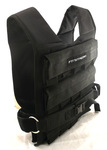Rope Climbing Instructions
- Grip the rope, one hand above the other, with the trail passing between your legs.
- Pull yourself up by bending at the elbows and at the top of the lift reach up to a higher part of the rope with the lower hand. Repeat this process to reach the top of the rope.
- You can pass the rope behind your leg and over the toes, using the other foot to stand on top of the rope (acting like a break). This can help you support your bodyweight if required and inch your way to the top.
Notes:
- Recommend 1.5" - 2" thick manilla rope.
- Challenge yourself to climb the rope as quick as possible
Rope Climbing Overview
Climbing a rope is an ancient exercise. It's such a simple action, but highly effective for physical development. There is a reason that the rope climb has been a staple exercise in military training and combat fitness for thousands of years - it is, quite simply, one of the best upper-body strength exercises available to you.
You will need a decent level of fitness before successfully practicing the rope climb. Many people approach the ropes with the tenacity and enthusiasm of their gym class days, when they scaled the school ropes with ease, only, as an adult to be left as a frustrated mess on the floor.
Building up the strength to support this exercise is highly worthwhile as you'll target many muscle groups (arms, shoulders, abs, back...), develop an iron grip and improve your coordination and agility skills. The rope climb has a real biceps dominance - check-out the biceps development of any consistent rope climber and they will be light-years ahead of average gym-goers.
Rope Climbing for Beginners
Rope climbing isn't an easy exercise and it's typically reserved for the fittest amongst us. You will need to be in decent physical shape to accomplish it, but it's worth the effort to learn.
Solid exercises you should develop competency in to help prepare you for the strength demands of the rope climb are -
- Pull-ups - for developing muscles for lifting your own body weight.
- Push-ups - for general development of the upper-body muscles with particular focus on building endurance levels.
- Sled pulls - for training similar muscles to the rope climb using weights you're comfortable with.
You can also try tying a kettlebell or dumbbell to the end of your rope and throwing the other end over a pull-up bar. You can then pull the kettlebell towards you to mimic the exercise with only a small portion of weight. You can increase the weight as you gain strength until it's not such a huge leap to hoisting your own bodyweight up the rope.
Advanced Rope Climbing
When comfortably scaling the rope in seconds, you can consider some of these more advanced rope climbing techniques -
Climbing without your feet
Remove the use of the feet when climbing the rope and lift yourself up with pure upper-body strength only for an additional challenge.
Weighted rope climbing
Adding additional weight to your rope climbs is a very effective way of increasing the exercise intensity and maximising development. Please note that weighted climbs should only be attempted when fully competent with bodyweight rope climbs, and you should start small and incrementally add weight.
- A weighted vest is a simple and versatile way of adding weight to your rope climbs. The great thing about weighted vests is that they're safe, comfortable and evenly distribute the weight over your body.
Other rope climbing exercises
- Climbing rope with feet
- Climbing rope without feet
- Climbing two ropes simultaneously
- Climbing upside down
Substitute rope climbing exercises
For those times that you simply don't have a climbing rope available to you but you don't want to skip those rope climbing sessions, here are some substitute exercises...
Towel pull-ups
The best substitute exercise for the rope climb are towel pull-ups, as they mimic the movement and thick grip demanded from the rope.
Throw a towel over a pull-up bar and grip either side of the bar with each hand. Alternate one hand high on the towel, the other low for increased realism. You should aim for 15 towel pull-ups to replicate the standard 15' rope climb of most gyms.
 Fitstream AppTrack your fitness progress and see the difference for yourself with our free app
Fitstream AppTrack your fitness progress and see the difference for yourself with our free app










